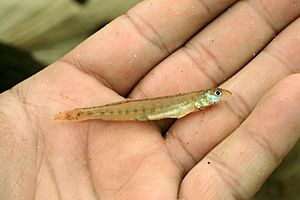Scaly sand darter facts for kids
Quick facts for kids Scaly sand darter |
|
|---|---|
 |
|
| Conservation status | |
| Scientific classification | |
| Synonyms | |
|
The scaly sand darter (Ammocrypta vivax) is a type of fish that lives in freshwater. It's a small fish called a darter, and it belongs to the same family as perches. You can find it only in the southeastern United States.
This fish usually lives in medium-sized streams. It likes places where the water moves slowly over sandy bottoms. The scaly sand darter eats tiny bugs like midge larvae and other small creatures. Its body is thin and a bit see-through, with a yellowish color. It has about a dozen dark stripes on its sides. This fish is quite common and lives in many places. Because of this, experts say it's a "least-concern species", meaning it's not in danger of disappearing.
Contents
What Does the Scaly Sand Darter Look Like?
The scaly sand darter has a long, somewhat round body. Its mouth is flat and horizontal, and its head is wide. Unlike some of its relatives, its body isn't completely see-through. It often has a yellowish tint.
- It has 9 to 16 dark, vertical stripes along its sides.
- You might see dark, uneven spots on its back.
- The scales on its sides look like they have faint black outlines.
- It has many dark spots in front of its eyes, reaching its snout.
- Its cheeks and gill covers can look shiny, like silver or blue.
- The underside of its body and head is usually yellow.
- Its fins have scattered black spots near their bases.
- The membranes of its pectoral and pelvic fins are creamy or yellow.
- The base of its tail fin is usually white or yellow.
- Male darters might have dark bands on their dorsal (back) and tail fins.
How Big Do Scaly Sand Darters Get?
The scaly sand darter is considered a large darter. Adult fish are usually about 50–58 mm (2.0-2.3 in) long. The longest one ever recorded was 63 mm (2.5 in). That fish was found in Okatoma Creek, Mississippi.
Where Does the Scaly Sand Darter Live?
These darters prefer streams that are not too big. They like areas where the water current is slow. They feed on tiny insect larvae that live in the sand. You can mostly find them in the Coastal Plain areas. This includes river systems that flow into the Gulf of Mexico. Their range stretches from the Pascagoula River in Mississippi. It goes west all the way to the San Jacinto River in Texas. They also live further north in the Mississippi River basin. You can find them in southeastern Missouri and western Kentucky.
Where Can You Find Scaly Sand Darters?
The scaly sand darter is found all over Mississippi. This includes the Pearl, Coastal, and Pascagoula River systems. These rivers drain into the Gulf of Mexico. They are also common in the Big Black drainage. You can find them in the Bayou Pierre system as well. This system is part of the lower Mississippi South drainage.
Scaly sand darters also live in the Hatchie River system in Mississippi. People have seen them in western rivers that flow into the Mississippi River. These areas include Louisiana, Arkansas, Oklahoma, and Missouri. The species is found from western Kentucky and southeastern Missouri. It goes south to southern Mississippi. It also extends west to eastern Oklahoma and Texas.
The number of these fish is not clear if it's growing or shrinking. However, it is a common species. It has many groups of fish spread over a large area. The International Union for Conservation of Nature says it is a "least-concern species". This means it's not currently at risk.
See also
 In Spanish: Ammocrypta vivax para niños
In Spanish: Ammocrypta vivax para niños


